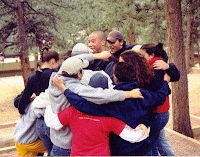Teambuilding Without Holding Hands
 We had a very productive retreat last week and at the end of it, there was a palpable sense of identity as a team. That was one of our goals, to build this team, along with the imperative of the design task that precipitated the idea of a retreat in the first place. When a retreat was first suggested a few weeks ago, it was met with nervous laughter, and comments which conjured images of a group hug (teambuilding seems to have become a bit of a punchline). So one challenge was to structure the retreat in a way that built the team, but did not have any recognizable “teambuilding” element.
We had a very productive retreat last week and at the end of it, there was a palpable sense of identity as a team. That was one of our goals, to build this team, along with the imperative of the design task that precipitated the idea of a retreat in the first place. When a retreat was first suggested a few weeks ago, it was met with nervous laughter, and comments which conjured images of a group hug (teambuilding seems to have become a bit of a punchline). So one challenge was to structure the retreat in a way that built the team, but did not have any recognizable “teambuilding” element.
Of course, teams that have worked together for a while are more comfortable with activities that explicitly explore the personal and behavioural side of team members and their inter-relationsips. With teams that are at an early stage, perhaps teams in name only, then a gentler approach seems to be more appropriate while trust is built.
I have read recently some revisionist teambuildng literature by McKinsey which argues against the touchy-feely kind of teambuilding front-loaded onto a retreat or meeting (the Gordian Knot or Squaring the Circle type activity – the titles speak for themselves). Instead they find that the teambuilding effect is greater when the work comes first and then space is opened at the end of the retreat to discuss how the group worked together. Therefore, reflection on how the team works and how it could improve its performance is based on a real work experience, rather than a simulated experience. We used this approach in the retreat and it seemed to work well, aside from the fact that time and attention at the end of any event are scarce resources. I found that people were much more willing to explore the process of working together after having had two days of structured work and some unstructured discussions, rather than having that group maintenance conversation in abstract at the beginning.
We paired this final process discussion with the StrengthsFinder, which people took in the breaks during the retreat (it takes about 30 minutes to take the online questionnaire and the results are instantly delivered). We each shared our top strength and how we felt that this strength had manifested itself in our contributions and behaviour during the retreat. We made a few joint comments to people, appreciating their specific roles in some of the key change moments in the meeting, and then generally discussed how we had worked together to achieve our goals. The discussion from next steps and task passed smoothly through to our process, in spite of having had limited focus in the past on what makes us all tick, separately and together. We even used a ball at the end so the group could self-facilitate the discussion. At that point, this was no issue. I could not have imagined introducing that at the beginning of the meeting when the urgency of the task, the tentativeness of group cohesion, and my reputation as an interactive facilitator were clearly in the “wait and see”category.
I still think there is a place for some of the more game-based teambuilding activities, perhaps with teams who are already formed and have specific issues or new ways of working that they want to explore. But with newly forming teams, and teams that are perhaps allergic to agendas with mysterious activity titles, I think that the get to work, and then talk deeply about how you did it approach is the way to go.



Leave a Reply
Want to join the discussion?Feel free to contribute!